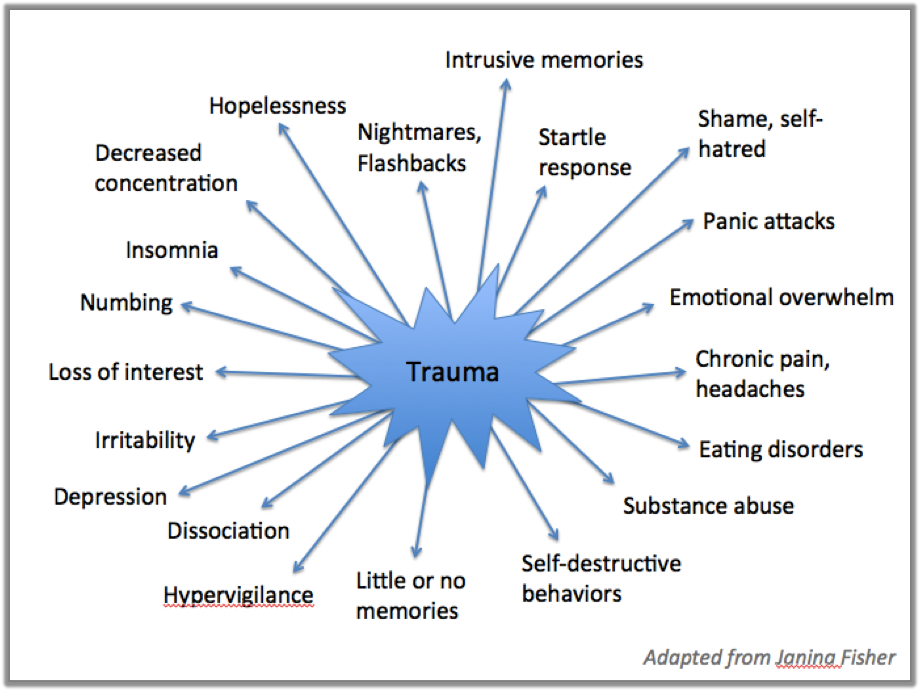You Are Not Broken: Trauma and its Symptoms
Sep 17, 2023
At the heart of the work of Embodied Intimacy is the following core insight:
In order to thrive in this life, to feel a sense of excitement and joy about who we are and to express ourselves fully, to experience genuine intimacy with those we love and relate well with the other humans in our world, we need to feel safe in our own body.
But one of the major things that undermines our felt sense of safety is being disconnected from our body.
And one of the major causes of the disconnection from our body is trauma.
Whether you personally identify as a trauma survivor or not, trauma is a pervasive feature of our modern world, and one that is increasingly impacting everyone’s lives.
But what is trauma, exactly?
What is trauma?
We can say that trauma occurs when we are alone with too much.
Something happens that is deeply painful or disturbing or distressing, either directly to us or in our immediate environment…
And the pain or distress we experience overwhelms us – it’s more than we can bear at that time…
It’s just too big, or intense, or incomprehensible for our system to cope with…
In that moment of overwhelm, a part of us is lost from conscious awareness, is torn away, as we dissociate from what we’re experiencing in order to protect ourselves from being annihilated by it…
This tear or dissociation is the beginning of trauma – a rupture in our psychological or emotional wholeness.
If there is external support at the time, or immediately after, to help us integrate or process what happened and bring it back into conscious awareness, then the rupture can be quickly repaired, and the dissociation healed before it becomes a trauma.
Then we can put the experience behind us and move on.
But if we find ourselves alone and unsupported, and have no way to process or integrate or make sense of the overwhelming experience, then the rupture sets in, and whatever was torn away lives on in our body, outside our conscious awareness, as trauma.
When this happens, we enter a partially dissociated state, constantly avoiding the pain of the traumatic experience we have separated ourselves from, and from the additional pain of the separation itself.
And because this pain lives in our body, avoiding it means abandoning our body itself – not always fully, but to some degree.
Symptoms of trauma
As a consequence of this dissociation, this abandonment, a number of symptoms can show up in us, some of which are presented in the diagram below (but there are many other symptoms not listed here).

Maybe you recognise some of these symptoms in your own life.
Or perhaps you are aware of manifesting other symptoms.
Or maybe you are living with a more generalised dissociation from your body, which doesn’t seem to have any specific symptoms but which you experience as a source of emptiness, dullness, lifelessness, meaningless, disconnection…
Trauma has so manifestations, which have such a huge impact on our lives and our world.
It can be super helpful to recognise that we and most of the people around us are probably living with the effects of trauma, and to begin to identify some of these effects or symptoms.
Doing so helps us to realise that we are not alone, or fundamentally flawed.
Self-compassion
Trauma symptoms aren’t anyone’s fault, nor are they unusual.
They don’t mean that we’re broken, or bad, or in any way unloveable.
All of the symptoms of trauma are consequences of the intelligent, protective response of our body to a situation that was (any maybe continues to be) overwhelming.
Whatever dissociation we are experiencing is a consequence of being alone with too much at some point (or repeatedly), and the body responding to this by trying its best to protect us from being utterly overwhelmed by it.
Knowing this, we can begin to feel a lot of compassion for ourselves and others.
And knowing that our various symptoms of trauma are a reaction in the present to a rupture that happened in the past, means that we don’t have to live forever in a state of dissociation – it’s not our inherent nature.
However long we might have been living with the impacts of trauma, it’s not too late to heal the rupture.
We can restore our sense of wholeness, and with it our sense of safety.
Doing so involves befriending the beautiful animal that is our embodied self, with its exquisitely sensitive nervous system and finely tuned survival instincts, in order to work directly with the body’s own intelligence in the process of integrating trauma and releasing its symptoms.
We call this process ‘somatic empowerment’, and it is the focus of our 'Core Teachings' series.
Next in that series is one of our favourite conceptual frameworks, the Window of Tolerance, which is a powerful piece in the somatic empowerment toolkit.
Also, if you’re experiencing trauma symptoms and would like some 1:1 support, Buster offers Sensorimotor Psychotherapy sessions through his private practice.
His client work is focused on helping people to feel more alive and connected in every sense, to address the root cause of mental health and behavioural problems, and transform the overwhelming effects of relational and developmental trauma into empowering relational growth and healing.
You can find out more and book sessions here →





